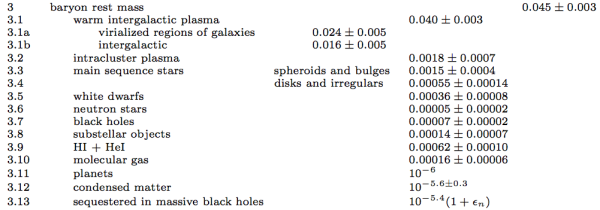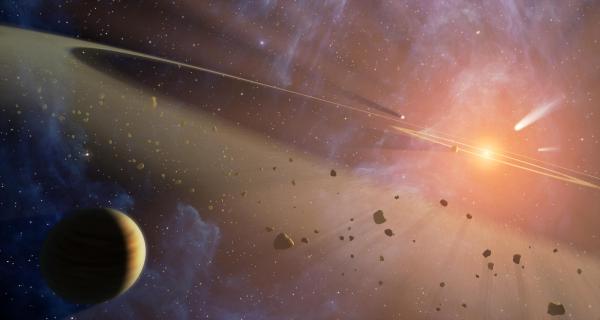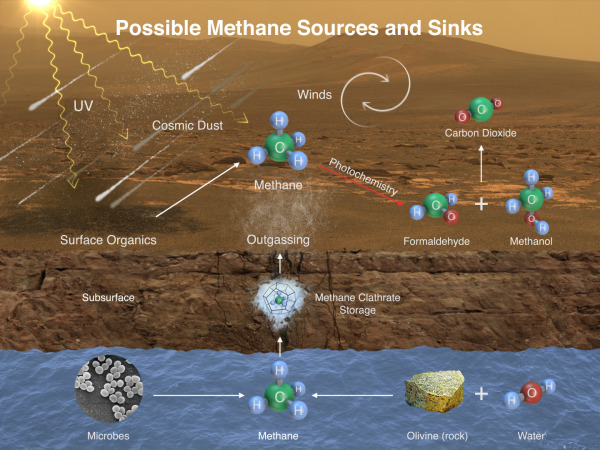“A journey is a person in itself; no two are alike. And all plans, safeguards, policing, and coercion are fruitless. We find that after years of struggle that we do not take a trip; a trip takes us.” -John Steinbeck
Here we are: the final Comments of the Week of 2014 here at Starts With A Bang, a year that's seen a tremendous number of changes, achievements, struggles and triumphs. This past week has perhaps been a microcosm for the entire year, with articles on cosmology, a new Monday series, a guest post and more. If you missed anything, here's what we've covered:
- Dark matter vs. dark energy (for Ask Ethan),
- The eclipse of a lifetime is coming (for our Weekend Diversion),
- Genesis episode 2, our Solar System (for Mini-Movie Monday),
- The rising star of science (another great post by Sabine Hossenfelder),
- Fixing Occam's razor, and
- The Christmas tree cluster (for the holidays).
You've had some interesting things to say, some of which was interesting, some of which was unexpected, and some things, in particular, that call for a response. I hope I won't let you down on this edition of our Comments of the Week!
Image credit: NASA; ESA; G. Illingworth, UCO/Lick Observatory and the University of California, Santa Cruz; R. Bouwens, UCO/Lick Observatory and Leiden University; and the HUDF09 Team.
From Omega Centauri on the unbound structures in our Universe: "Presumably any ordinary matter still in the underdense regions will never form stars or galaxies. Do you have an estimate of what fraction of the ordinary matter participates in galaxies, and intergalactic gas within galaxy clusters. If you postulate a purpose for the universe is to make galaxies, then this fraction would be considered to be the (matter) efficiency of the universe. Is it much less than 1?"
It's easy to look out at the galaxies -- the brilliant sources of light in the heavens -- and guess that's where the Universe's mass and energy is. But what we're seeing is the stars alone: some 0.5% of the total mass within galaxies. What's even stranger than that, perhaps, is that we believe that the majority of matter in the Universe isn't even bound within galaxies, but rather exists as part of the intergalactic medium! There was a great paper about a decade ago (here) on the cosmic energy inventory, where they went through not only how energy was broken down in the form of dark energy, dark matter, normal matter, neutrinos and radiation, but broke down the normal matter into all its known components. Here is the summary of results for normal matter, as you requested.
 Image credit: Masataka Fukugita, P. J. E. Peebles, via http://arxiv.org/abs/astro-ph/0406095.
Image credit: Masataka Fukugita, P. J. E. Peebles, via http://arxiv.org/abs/astro-ph/0406095.
This is still pretty accurate, and -- as you can see -- about 6% of the total baryons are in the form of stars, about 2% in the form of neutral gas, but the biggest number is that about 90% of the baryons make up the warm, intergalactic plasma.
Of this, about 60% is found in the virialized region (i.e., gravitationally bound) around galaxies, and about 40% is found in intergalactic space, completely unbound to clusters. According to this work, about 36% of the total matter is then found outside of any bound structure. This is roughly consistent with the 40-50% figure I've seen recently from other sources. But yes, the "matter efficiency" of the Universe, as you call it, is significantly less than 1.
Image credit: Romeo Durscher, via http://www.nasa.gov/mission_pages/sunearth/news/totaleclipse-20121113.h….
From George on the eclipse of a lifetime: "Furthermore those lucky enough to be able to get to Illinois can return seven years later to exactly the same spot and watch the 2024 total eclipse. Now that’s a rare opportunity."
You know, I try hard to avoid both a northern hemisphere and a USA-specific bias, but I know I can't help myself sometimes. When it comes to total eclipses, we've really been unlucky (as far as luck has anything to do with it) over the past few decades, which, you know, makes up my lifetime so far. The last total solar eclipse to occur over the contiguous United States was way back on February 26, 1979, when I was six months old. I had an 88% partial eclipse when I was a teenager that was really interesting (light but not heat from the Sun! Bizarre shadows! Seeing it directly with eclipse glasses!), but not a lot of opportunity for another experience since. That all changed two years ago, when I went on an expedition to see my very first annular eclipse, and it was a spectacular occurrence.
So you'll have to pardon my excitement, but our drought will extend to 38 years in advance of this 2017 eclipse, but then we get five in a 35-year span: in 2017, 2024, 2044, 2045, and then once more on March 30th, 2052. (With a little luck, I will still be around at 73 for that one.) So it is -- for pretty much anyone in the USA who's my age or younger -- our first real chance to experience a total solar eclipse. While being in southern Illinois means you won't have to move to see it, moving around is a small price to pay to go and hunt all five!
 Image credit: NASA/JPL-Caltech/T. Pyle (SSC), via http://www.spitzer.caltech.edu/images/1966-ssc2008-19a-Epsilon-Eridani-….
Image credit: NASA/JPL-Caltech/T. Pyle (SSC), via http://www.spitzer.caltech.edu/images/1966-ssc2008-19a-Epsilon-Eridani-….
From Armando on our Solar System's origins: "How do moons arise and what exactly defines a moon?"
Briefly, there are three ways:
- You can be a gravitationally captured body -- either an asteroid or a Kuiper belt object -- by a planet.
- You could have formed from an early-stage disk around a larger world; this is where the gas giants' moons predominantly come from.
- Or, you could have formed from a rare, catastrophic collision in the early Solar System.
That third one, mind you, is where we think our own Moon comes from, and -- I promise -- will be the topic of a future mini-movie Monday!
From zav, who has a strong opinion about my personal appearance: "Geez, Ethan looks like a freak. It’s hard to take someone who looks like that seriously."
One of the unfortunate consequences of putting yourself out there in the public eye is that you're going to get comments like this. You're going to get people who won't judge you by the quality of the content you produce, by your merits or lack thereof, but rather by their own opinions of what someone in your position ought to look like, by some arbitrary standard.
Let me say it unequivocally: I have nothing to be ashamed of when it comes to my appearance. I am proud of who I am and how I present myself to the world, and if you can't accept me in the role of whatever it is that I choose to do because of my appearance, I strongly suggest you look inwards, and ask yourself why that is. Perhaps you should reconsider how you judge people based on the way they look; you never know who just might turn out to be exactly the kind of person you'd hope to see more of in your life.
From daedalus2u on Occam's Razor: "I would be surprised if there is not life on Mars. It likely won’t be found on the surface, but until there have been holes drilled deep enough into Mars that temperatures above 150 C are reached, in multiple places, I would not dismiss the possibility."
It's very difficult to gauge just what we're looking at from a sample size of one: that is, we have one place in the Universe where we know life exists, and many places in the Universe where we know the ingredients for life exist, yet no surefire evidence that life is there. I think it's important to look, and I think it's important to be open to the possibilities that what exists elsewhere may be extremely different from life on Earth, or what we imagine that life elsewhere might look like.
But let's also not claim that any signature that could just as easily be due to geologic or inorganic processes is an indicator of life. We're talking about methane, something produced in copious amounts inorganically all over the place. (Hello, Titan, anyone?) Yes, it could be a sign of life, but why one would think that was a likely option given what we know, that I don't understand.
Image credit: Flickr user Alicia, via https://www.flickr.com/photos/capella_891/2779209611/.
And finally, from Sinisa Lazarek on the Christmas Tree Cluster: "Dear Universe, please don’t send any high energy jets toward us in 2015, otherwise it’s all great!
"
Please, don't go away just yet; there's another great week of Starts With A Bang to enjoy before the new year. I promise, I'll make it worth your while!
Have a great weekend, thanks for a great set of comments, and I'll see you back here (hopefully very) soon!
- Log in to post comments









'From Analogue Models to Gravitating Vacuum'
http://arxiv.org/abs/1111.1155
"The aether of the 21-st century is the quantum vacuum, which is a new form of matter. This is the real substance"
There is no such thing as non-baryonic dark matter anchored to matter. Matter moves through and displaces the aether.
What ripples when galaxy clusters collide is what waves in a double slit experiment; the aether.
Einstein's gravitational wave is de Broglie's wave of wave-particle duality; both are waves in the aether.
Aether displaced by matter relates general relativity and quantum mechanics.
Ieia - You are right on track concerning the displacement of aether within Matter Topologies. I recommend everyone check out Tetryonics. There is great insight to be had, and momentum is building concerning where this geometrical, mechanical, fully deterministic theory can be applied. You're going to what the Tetryonic perspective brings to the table. A distinction between mass and Matter. The quantum of energy as being that of an equilateral geometry, and the fact that a single charge boson should never be equated to that of a dual charged photon. 2hv=E=hf,,,never confuses the quantum of energy, a boson, with that of a quantum of light. Erroneous assumptions are now revealed for what they really are. Welcome to a new era in scientific understanding.
Photons are comprised of dual charge bosons that have combined to form a neutral quantum of energy momenta [light].
A photon's quantum charge geometry is self-similar to the EM wave it creates and it part of, and it propagates at 'c' for the medium it is within.
Each photon has a quantum magnetic moment which enables to it be polarised and refracted as it passes through fields external to it.
Using equilateral energy all the geometries of quantum EM mass-Matter particles can be physically modeled revealing the known Standard Model particles.
Bosons are shown to be transverse EM fields that facilitate EM induction and Photons are revealed as longitudinal dual charge pairs possessing a neutral EM charge and inherent magnetic moment.
The net unidirectional momentum of bosons then distinguishes them from the Photons that possess a bidirectional momentum.
Closer examination of the geometries highlights a long standing error in the mathematical formulation of QM energy formulas, namely the mistaken interchanging of Planck's quanta [v] for Einstein's frequency [f] in relation to Energy.
2D EM masses [BosonsPhotons] do not possess the physical property of 3D Matter [Fermions]. Fermions can now be defined as the standing wave energy geometries that create all the known subatomic particles the building blocks of large scale Matter and structure in the macro world.
Hi Leia,
You're new here, so I can forgive your first few comments. We have a comments policy that I highly recommend you check out here: http://scienceblogs.com/startswithabang/comments-policy/
We generally don't stand for the non-relevant-to-the-topic-at-hand promotion of your own scientific theories and ideas, and the aether is certainly out of bounds as far as scientific relevancy.
I have deleted your comment and although you are welcome to participate in the discussion here surrounding any and all of the topics that come up, please do respect our comments policy and -- if you must talk about the aether -- please do it in the designated place on this blog for it.
Thank you!
Understanding what waves in a double slit experiment is "out of bounds as far as scientific relevancy"?
'EPR program: a local interpretation of QM'
http://arxiv.org/abs/1412.5612
"Wave particle duality is described as the compound system of point particle plus accompanying wave (in the æther)."
Where is the designated place to correctly discuss what occurs physically in nature on this blog?
Hey Ethan, I'm glad you shot that zav down, keep your appearances as you like. I've always enjoyed your Halloween costumes and I enjoy showing my daughter someone who is a scientist and dresses up like rainbow dash. Keep up the good work.
You may want to talk a bit slower in your videos though :)
leia, instead of spamming your crap all over the site, read this and post here where you won’t be banned for antisocial behaviour:
http://scienceblogs.com/startswithabang/2012/09/23/weekend-diversion-yo…
Refuse to go and you can be banned.
Ethan,
Re the previous comment by Wow.
Has that antisocial shitbird been appointed as a moderator of this blog?
Here is a second article where the aether is what waves in a double slit experiment. There will be more as understanding the particle always travels through a single slit and the associated wave in the aether passes through both is the most correct explanation to date for the observed behaviors in a double slit experiment.
'From the Newton's laws to motions of the fluid and superfluid vacuum: vortex tubes, rings, and others'
http://arxiv.org/abs/1403.3900
In a double slit experiment the particle travels a well defined path which takes it through one slit. The associated wave in the aether passes through both. As the wave exits the slits it creates wave interference. As the particle exits a single slit the direction it travels is altered by the wave interference. This is the wave guiding the particle. Detecting the particle strongly exiting a single slit destroys the cohesion between the particle and its associated wave in the aether, the particle continues on the trajectory it was traveling and does not form an interference pattern.
Re. "The Rising Star of Science" (as I didn't have time to read it or comment until today):
"In the public mind, science is ...facts and numbers, sterile and soulless."
I would argue, only "sterile and soulless" if "the public mind" is profoundly ignorant of the meanings of facts, and profoundly mathematically illiterate. Consider how largely-illiterate people view literature, and how they view the scriptures of cultures other than their own: as irrelevant, meaningless, and vaguely threatening.
Our task is to educate the public, including by making science as inspiring as conventional religion (which is exactly what you have been doing with this blog). ( _Not_ by scolding people about their existing beliefs, or by being condescending or otherwise off-putting, which frequently occurs in other forums elsewhere.)
But let's take one step further.
The essential aspects of religion are not belief in a deity or a supernatural explanation of reality, or a scripture or priesthood with supreme authority. For example some sects of Buddhism and some sects of paganism have none of this.
At root, religion deals with questions of value: meaning, purpose, morality, and the resulting praxis (how one lives one's life and treats others). These issues are orthogonal to science rather than oppositional.
There is no reason that one cannot arrive (via any of a number of intellectually honest routes) at a set of religious values that are based in our scientific understanding of nature, or, at most, that add theistic elements that do not conflict (e.g. Deism).
There is reason to believe we are seeing the beginnings of this, widely scattered throughout the culture. On one hand, neo-pagan groups that are grounded in scientific ecology and espouse values such as the sacredness (irreducible intrinsic value) of nature. On the other hand (and to my mind, highly misguided), The Singularity, whose deity is an outgrowth of computer science. There are others, most of them with tiny numbers of adherents, but none the less seeds of new belief systems that are in various ways derived from scientific understanding of the universe.
Working scientists and technologists have an opportunity, I would say an obligation, to articulate our value systems, and to do it explicitly. It's one thing to say, for example, "I'm a utilitarian (or a Kantian, etc.)." But it's far more interesting and informative to explain the relationship between one's grasp of the realities of the physical universe, and the values one holds sacred, and the ways in which one lives according to one's values. This is part of the path forward toward making science a core part of the "working paradigm" of the average person.
Hi Ethan.
Im sorry but Zav is right. Your appearance is both unexpected and amusing :)
That said I really do like the content on this excellent blog. Keep up the good work.
Kind regards.
Johan
I also applaud your mature handling of the comments on your appearance. It's less common for men to be criticized for their looks, but as a female scientist i can assure you my presentation to the world is constantly scrutinized. I am proud to count you in our number as a fellow oddball and researcher, and i hope we can attract more intelligent, articulate, bizarre-looking colleagues by being ourselves instead of conforming to someone else's notion of how a scientist looks :)